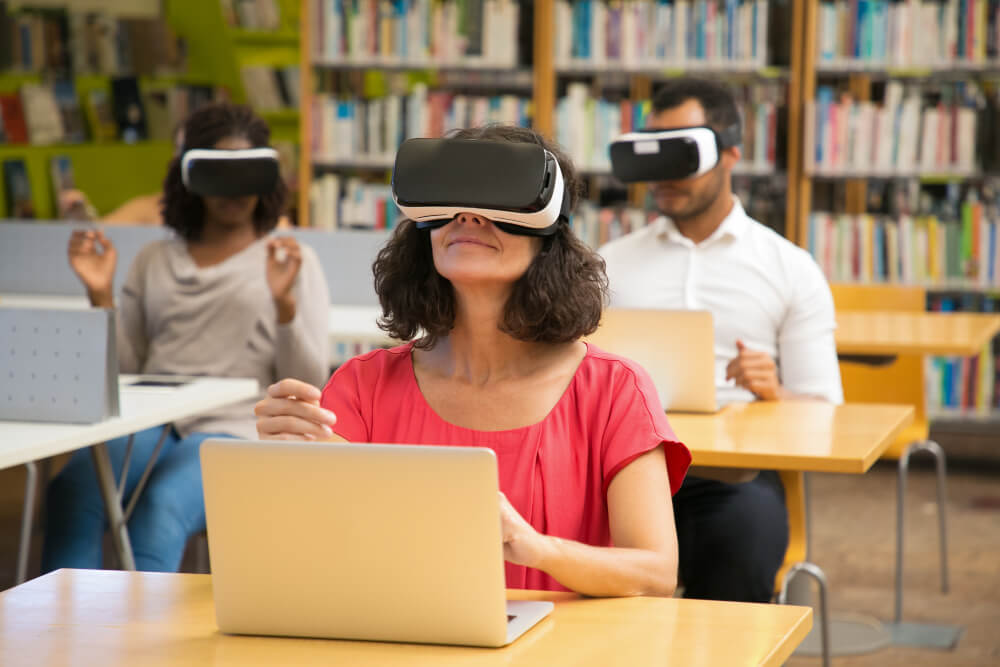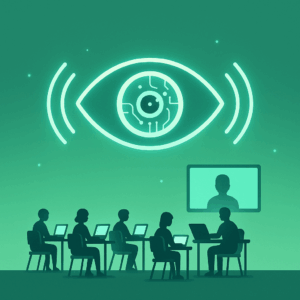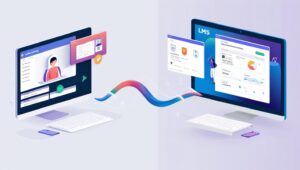Virtual Reality (VR) has been gaining momentum in recent years, and it is not hard to see why. This cutting-edge technology offers a unique and immersive experience that has the potential to revolutionize the way we learn. In this blog, we will explore the future of Virtual Reality in eLearning and how it will shape the eLearning industry.
What is Virtual Reality?

Virtual Reality is a technology that enables users to experience a simulated environment using VR headsets or other devices. The VR environment can be a completely immersive experience, allowing users to interact with virtual objects and explore simulated environments. This technology is already in use in various industries, including gaming, entertainment, and healthcare.
What Is E-Learning?
eLearning, or electronic learning, refers to delivering educational material and training through digital platforms such as computers, tablets, or smartphones. It can take many forms, including online courses, webinars, virtual classrooms, and interactive videos. e-Learning provides learners with flexibility, allowing them to access content anytime and anywhere, making it an ideal solution for remote and distance learning. Additionally, eLearning offers a personalized and self-paced learning experience, enabling learners to study at their speed and according to their schedule. As technology advances, the possibilities for eLearning continue to expand, making it a powerful tool for education and training.
How is VR Technology Used in eLearning?

VR technology can transform eLearning by providing learners with a more engaging and immersive experience. It allows learners to interact with the learning content impossibly with traditional eLearning methods. With VR technology, learners can explore virtual worlds, simulate real-life scenarios, and engage more meaningfully and interactively with content.
VR tools are being developed specifically for eLearning to create immersive learning experiences that engage learners and enhance their understanding of complex concepts. These tools include VR eLearning software allowing educators to create VR content and online learning management apps incorporating VR technology.
The Benefits of Using VR in eLearning
There are many benefits to using VR technology in eLearning. Here are just a few of them:
Improved Engagement: VR technology provides an immersive and interactive learning experience that is more engaging than traditional eLearning methods. Hence, it allows learners to engage with the content more meaningfully and meaningfully.
Realistic Simulations: VR technology allows educators to create realistic simulations that provide learners practical experience without expensive equipment or resources. This can be particularly useful in industries such as aviation and manufacturing, where training can be costly and time-consuming.
Reduced Cost and Time: By simulating real-world scenarios, learners can gain practical experience without needing expensive equipment or resources. This can reduce the cost and time associated with training.
Enhanced Learning Outcomes: Studies have shown that VR technology can improve learning outcomes by providing learners with a more engaging and immersive learning experience.
Challenges of Using VR in eLearning
While the benefits of using VR in eLearning are significant, some challenges need closer consideration. One of the main challenges is the cost of VR equipment, which can be prohibitively expensive for some learners and educators. Another challenge is the need for specialized skills to create VR content. Developing high-quality VR content requires 3D modeling, game design, and programming expertise.
However, VR equipment costs are expected to decrease as technology advances, making it more accessible to a wider audience. Additionally, many companies and individuals specialize in creating VR content for eLearning. As the demand for VR content increases, we can expect to see more companies offering these services.
Summing up: The Future of Virtual Reality in eLearning
The use of VR technology in eLearning is still in its early stages, but the potential is enormous. We can expect more eLearning companies to incorporate VR into their solutions as technology advances. This will provide learners a more engaging and immersive learning experience and help improve eLearning’s effectiveness.
Online learning platforms should incorporate VR technology in the future. Indeed, this will provide learners with a more flexible and accessible learning experience, allowing them to access VR content anywhere in the world. VR technology will play a significant role in the future of education. With the ability to create realistic simulations, educators can provide learners with practical experience that is difficult to replicate.











